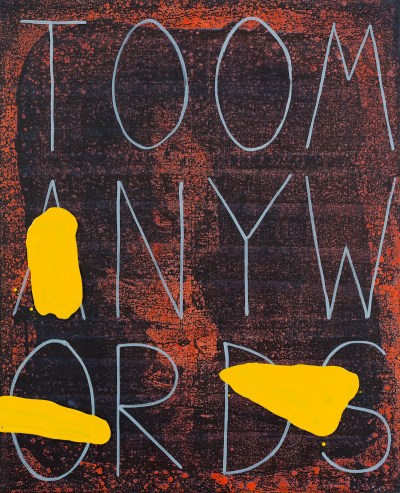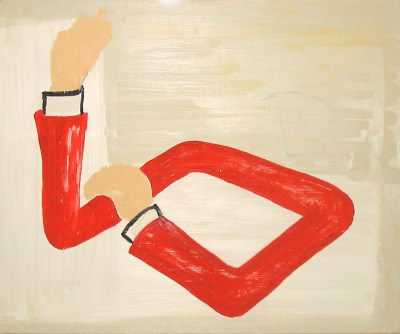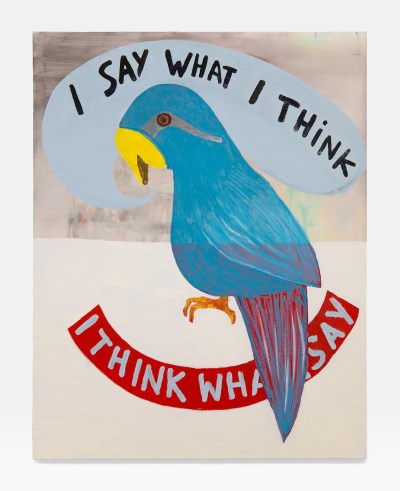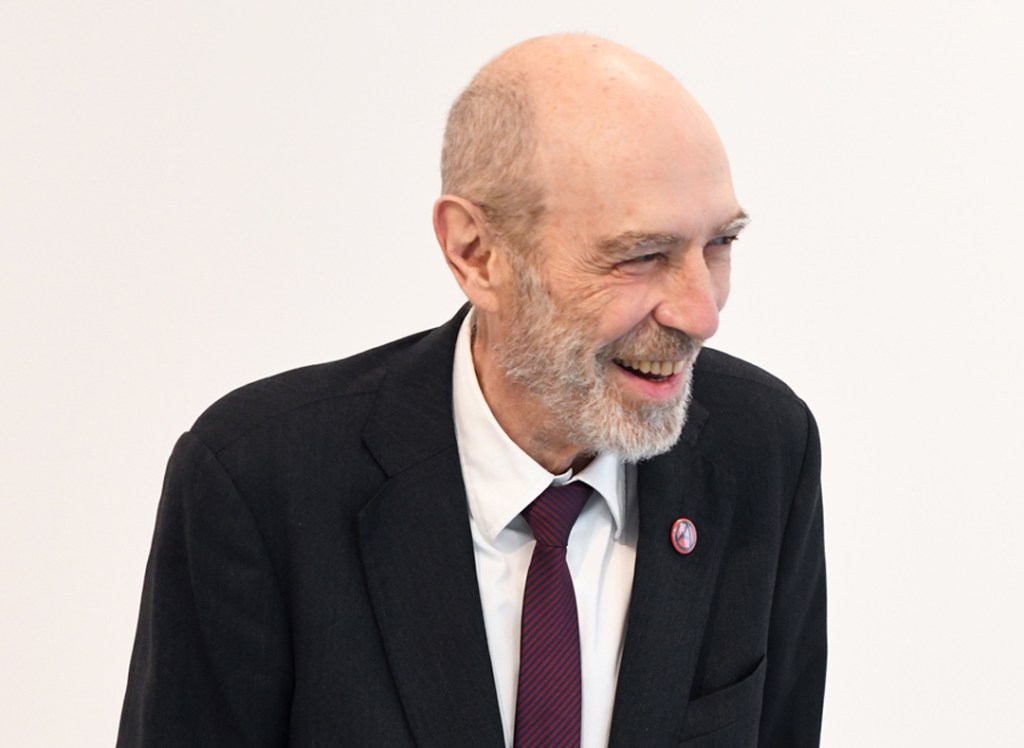Walter Swennen, an artist who began as a poet and later channeled his interest in language into wild, weird paintings, has died at 79. His death was announced by his gallery, Xavier Hufkens, which did not specify a cause.
Swennen rose to fame in Belgium alongside a range of painters interested in the medium’s material properties. But unlike many of his compatriots, Swennen’s art was freer and more playful, filled with written phrases that appeared to be jokes but did not immediately impart their meaning. Alongside those cryptic words, in various languages, Swennen would sometimes paint figures that appeared to have been borrowed from comic books.
Many of his paintings are drily funny. One from 2015 spells out the phrase “FEED THE FISH” in big red letters, followed by a second phrase in loopy cursive: “at your own risk.” Another features a bodiless set of arms contorted to form the fuck-you bras d’honneur gesture. Yet another features a banana peel against a black void, seemingly positioned so that someone might slip on it.
His paintings tended to render language unstable. Swennen’s words “fight for space with nonsignifying elements, and dissolve into them,” critic Mark Prince wrote in a 2012 review for Art in America. “English, French and Flemish speak over each other. The abstraction of a word phases into abstraction as a manifestation of irreducibly visual painterliness.”
Swennen approached such unusual material by painting in ways that were fittingly rather odd. Rather than using conventional wooden supports for his canvases, Swennen often appropriated found pieces of wood and plastic. Sometimes, he would even sub out canvas altogether for wood or metal.

Walter Swennen, Too many words, 2017.
Courtesy the artist and Xavier Hufkens
He said in interviews that his method was in part a commentary on what counts as “good” in painting. “I do try to paint against my taste—not only against ‘good taste’ but also in the spirit of disinclination, which I consider a virtue,” he told Frieze in 2016. “It’s difficult to paint against taste. But painting has been very difficult for a long time.”
His off-kilter humor had already charmed critics and artists in Belgium by the time he began to find a loyal following in New York during the 2010s. More than 20 years after his first New York solo show, at Nicole Klagsbrun Gallery in the early ’90s, Swennen began showing at Gladstone Gallery in 2015. Of the works in that show, New York Times art critic Roberta Smith wrote, “Mr. Swennen seems to have found maturity in a determination to extract a maximum of beauty and humor from a minimum of paint.”
Walter Swennen was born in Forest, Belgium, in 1946. When he was 5 years old, his parents decided to have their son begin speaking French instead of Flemish, instilling in Swennen an interest in words, language, and meaning early on. After graduating high school, he studied philosophy and engraving before working toward a degree in psychology at the Université catholique de Louvain.
During the ’60s, he began writing poetry, gaining him the attention of artists such as Marcel Broodthaers. Swennen also began painting and drawing during this time, but he didn’t fully commit himself to a painting career until the ’80s.

Walter Swennen, Bras d’honneur, 2003.
Courtesy the artist and Xavier Hufkens
In his Frieze interview, he said, “I was happy that I became a painter because I thought painters don’t have to speak. And anyway, from the 1960s on, I had been painting, and studying painting, privately.” Still, he seemed uncomfortable with the notion that he had finally made it as a painter. He noted that he was “not really in the art world,” adding, “What’s more, I don’t have a trademark style and that’s a problem for galleries and collectors.”
Also in that interview, Swennen credited a traveling retrospective that visited Brussels’s WIELS Contemporary Art Centre in 2013 with jumpstarting his career anew. He said that younger artists began looking at his work, and that the dealer Barbara Gladstone, whose gallery has a space in Brussels, met with him as a result of the show.
He suddenly began exhibiting with blue-chip galleries: Xavier Hufkens started showing him in 2014, and Gladstone would go on to give him three solo outings. One of those Gladstone shows also coincided with an exhibition at White Columns, a storied New York alternative space.
Swennen’s CV does not list a single appearance in the Venice Biennale or Documenta, the world’s two biggest recurring art exhibitions. But his influence on younger artists is clear: Sanya Kantarovsky included Swennen’s work in a group show he organized for the defunct New York gallery Metro Pictures, and Mathew Cerletty and Eddie Martinez, two painters several generations Swennen’s junior, showed their art alongside his.
Swennen said in the Frieze interview that his Gladstone shows had given him an unlikely taste of international success. “I understood what it is to live like a king,” he said. “I would like to be a king one day a week!”

Walter Swennen, Tautologist, 2024.
Courtesy the artist and Xavier Hufkens
